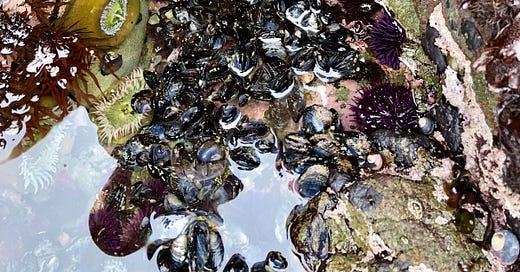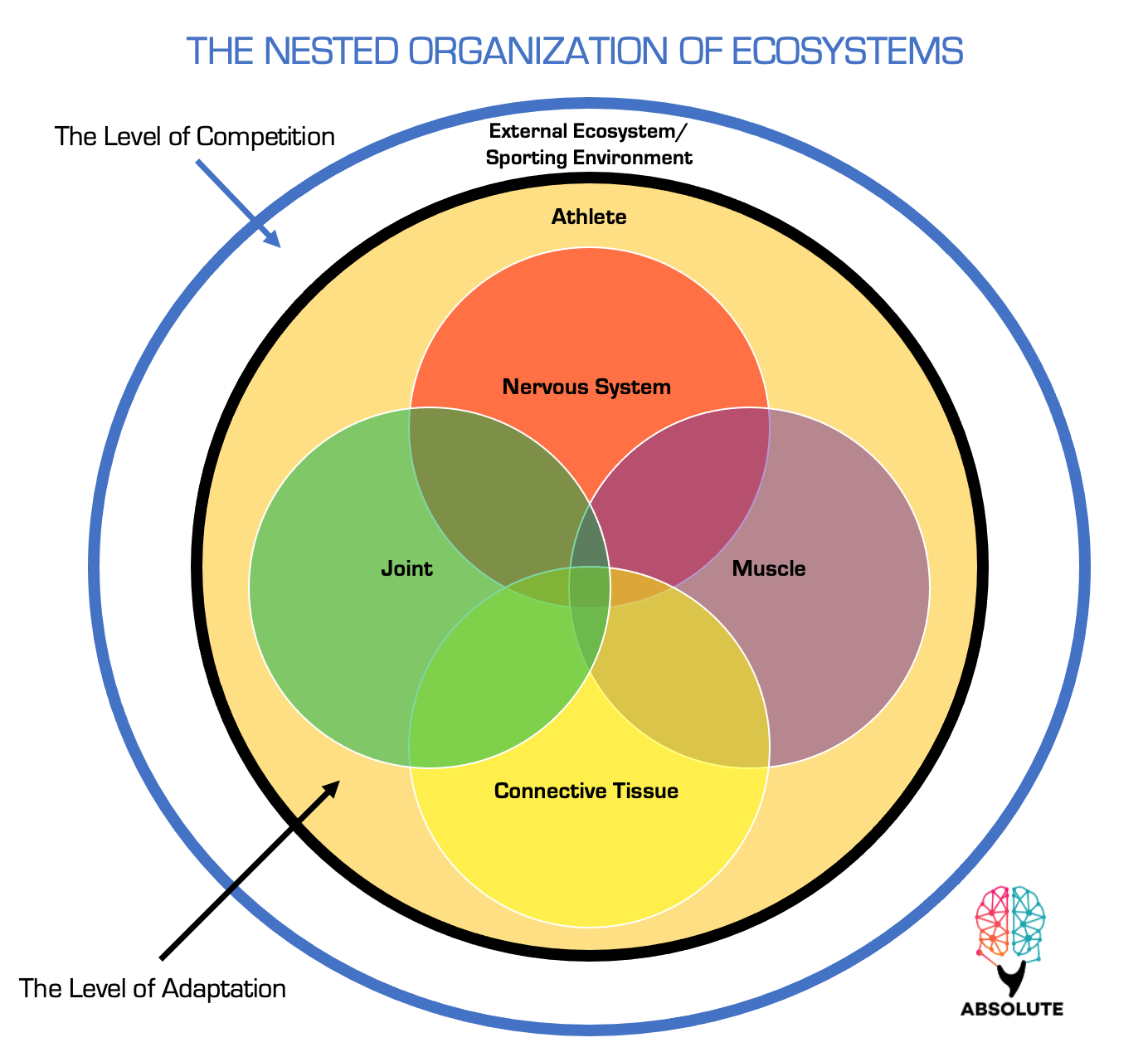Ecosystems
Performance is based on the continued development of both the individual and their physical impact on their sport. — Dr. Michael Chivers
Imagine a natural ecosystem and its unique environments. Take into account the biodiversity and richness of the living and non-living organisms that interact in that environment. These factors dictate whether or not an ecosystem is healthy and performing “well” or not. The overall health and performance of the ecosystem are determined by the connectedness of individual elements interacting and behaving in a functional manner. Similarly, if we look at an individual athlete as an ecosystem, he or she too is comprised of elements that interact with one another in their environment — the internal environment of the individual themselves. The health of these elements determines the health of the system they are a part of and of the greater whole of the organism — the individual's physical health.
Humans, like other external ecosystems, have ecosystems with individual elements within ecosystems. The nervous system, the fascial or connective tissue system, cardiovascular system, immune system, endocrine system, skeletal system, muscular system, digestive system, reproductive system, and others all have parts that make up the entirety of the system. The human heart is one bit that makes up the cardiovascular system. Neither the system nor the heart would exist without the other, and a human can’t survive without a heart or a way to circulate the blood.
Capacity > Demands
On weekends my fiancé and I enjoy exploring the Northern California coastline in the tidal pools. Tide pools are one of the most chaotic, diverse, and adaptable ecosystems on the planet, as the environment literally changes from high to low tide twice daily. In such a demanding environment, the plants and animals that call this place home have evolved and developed the necessary physical capacities to exceed the environmental demands and will continue to do so as long as they continue to receive stress, ensuring only the fittest of species can survive this ecological niche. Otherwise, they will cease to exist in that ecosystem.
Individual sports are ecosystems and vary on a chaos and demands spectrum. I’d say darts is pretty low on that spectrum compared to the NFL or rugby. Simply saying that the physical demands to survive in the NFL far exceed the physical and chaotic demands of a darts player.
So then how does an NFL player continuously develop himself over the course of their career whilst maintaining his elite level of performance?
I know it is the belief of Absolute, that if our intention is the furtherance of the performance of an individual, an ecological training system is the only logical means of doing so.
I agree.
Training Ecologically
Training is a tool by which we can funnel specific work into specific tissues in order to elicit traits necessary for any given sport or ecosystem. The trick is doing so in multiple environments simultaneously.
Ecosystems are dynamic and are never at equilibrium. The environment is always changing and so must the elements within the environment. In observing tide pools and their inhabitants, the likes of kelp, seagrass, corals, fungi, snails, sea stars, sea urchins, sea slugs, octopus, crustaceans, crabs, and sea anemones. These plants and animals are always in perpetual motion, or something is moving around them. They are at the mercy of the ocean’s gentle calmness or savage violence and everything in between.
An NFL game is also filled with chaos. Watch an NFL football game and observe the various speeds of plays, which direction the run is going, the pass blocking, the violence of collisions, the double-teaming, a fumble, a blown play, hurry-up offense, and playing in the snow on astroturf. What kind of traits do various positions possess in order to not just perform in this particular game, but survive over time?
Football players and sea creatures in a tide pool both need to be highly trained and dynamic in order to survive in their chaotic environments.
Like any system, if you observe it long enough you can come to recognize its behaviors and traits. The vegetation in the ocean flows with the water like tall grass in the wind, literally just going with the flow of force. An NFL lineman, thanks to mobile joints and tissues, can change his shape and dissipate the force of his opponent, given he has the right capacity for that specific task (his opponent is weaker than he is) while still maintaining his functionality of a human and lineman.
I have noticed the animals in the shallow pools are either very soft and malleable like jello, or hard as a rock, being able to absorb and dissipate the force(s) of the waves. Consider the connective tissue of the lineman’s lumbar spine; does it have the capacities, i.e., can the architecture of that tissue change shape, stiffen quickly, lengthen, resist, and transmit forces at the speed and intensity of his interaction with his opponent? If not, then there’s the potential for ecological breakdown. This is how injury can befall an athlete, much like any toxic or harmful external influence can damage a coral reef. Imagine waves of the ocean like plays in football; they come at different frequencies, velocities, and magnitudes. One has to have the capacity to withstand those kinds of demands.
I have been amazed at the tremendous amount of strength some of these animals display. Try and pull an abalone off of a rock with your bare hands, or barnacles, muscles, or a large sea star. There is no chance. They have developed the strength to grab ahold of a rock and resist all types of forces placed on them as if they were the rock themselves. An NFL lineman also must be able to display a range of strengths on a spectrum of velocities. The likes of absolute strength, eccentric strength, static strength, and strength endurance. Not to mention a strong cardio base.
Strength, resilience, flexibility, mobility, structure, and adaptability. Traits that when given stress, will respond by either absorbing and dissipating that stress, as it is beneath their physical capacity. Or if the stressor is intense enough and is at the threshold of its capacity, the system will self-organize and self-repair so as to manage that particular stressor again in the future. Lastly, if the stress outweighs the capacity injury will occur.
Push Adaptation
In her book Thinking in Systems: A Primer, Donella Meadows discusses the ability of systems, biological ones to organize themselves.
Biological systems have the ability to self-organize, evolve, and adapt. They can structure themselves, to create new structures, to learn, diversify, and complexify.
Mother Nature has selected these traits over the course of millennia in order for these species to survive in their niches. If the individual is continuously changing in a positive manner, by way of variable stresses from his or her environment, they will in turn be better suited for their environmental demands. With their capacities matching or exceeding the demands, they can continue to play a part in the performance of the ecosystem on both the internal and external levels.
As a manual therapist and strength coach, it is my role to know when and where to push adaptation while driving recovery into others. I am in a sense acting as Mother Nature, controlling the chaos. As a manual therapist, I observe the physical capacities of specific biological elements within the human ecosystem. In conjunction, I take into account the demands of the athlete’s particular sport. Training allows me the ability to close the gap and hedge the person in such a way to ensure their internal environment has the capacity to engage in and withstand those demands.
As is common in the training of athletes today, it mainly takes place in the external environment. Arbitrarily training with weights to try and improve sports performance at the cost of the athlete. This method of training leaves a huge blindspot and potential for growth at the individual level.
We have discussed some of the demands that are required for an NFL lineman. We cannot train all of these demands at once, and hopefully, he already has some that don’t need any improvement. Remember, we are training to acquire physical capacities that are at or above the demands of a given sport, as this is how we will allow individuals to perform on a continual basis.
This is where we aim to maintain some capacities and build others. Say a lineman in my care can bench press 500 pounds. I know the average lineman is roughly 320 pounds and he can move that weight on the bench quickly. I don’t need to focus on building his absolute strength in the bench press. Rather, I will program a stimulus at which he can maintain his bench while building up his anterior shoulder joint connective tissue and its ability to bear load, as I know that pec tears and labral injuries on common for his position.
Once we have achieved that goal, we can move on to other weaknesses we have assessed. Maybe he is experiencing low back pain and his lower body strength is decreasing as a result of his back. pain. With a systematic training approach, we can observe and intervene at specific joints and connective tissue levels of the lumbar spine to improve their physical capacities while concurrently training absolute strength and rate of force development in the lower body in a way that doesn’t put any more load on the spine.
A healthy ecosystem has a lot of biodiversities. A tide pool with a solitary starfish isn’t very ecological. A lineman who only trains with weights also is non-ecological. Create more diversity in the system to allow for more interconnectedness, self-organization, adaptation, and growth to occur. Biodiversity for athletes looks like more joint workspace, more joint capsule space, more and better quality connective tissue architecture, and more connective tissue load-bearing capacity.
Train The Individual
Ecosystems have environmental demands. Most people only think in regards to the external environment, completely neglecting the internal environment from which our interactions and behaviors emerge.
It is not enough to train externally to try and systematically affect the internal components.
Training ecologically rather, is the process of training at the internal level in conjunction with the external in order to improve physical capacity for skill acquisition and performance. This is how we train and affect multiple environments simultaneously.
Where to find Brian:
virtual internal strength training platform: Gain Acces
works cited
Meadows, Donella H., and Diana Wright. Thinking in Systems: a Primer. Earthscan, 2009.








This really resonates with the philosophy of my Osteopathic learning, so cool. Love the concept of viewing the body as an ecosystem and a relationship between all systems dictating efficacy for maintenance of health and improving performance. Great article Brian!
Beautiful article Brian, great analogies!!!